Many companies these days are looking for ways to improve customer service and reduce customer effort. Customer Effort Score (CES) is one of the important metrics to measure customer satisfaction. It helps in understanding how much effort the customer has to put in to get their desired outcome. Start-ups can use this information to improve the customer experience and keep them coming back for more. This article will discuss everything you need to know about CES and how you can use it for your business. Stay tuned!
What is Customer Effort Score?
The customer effort score (CES) is a metric that measures how much effort a customer has to put forth to use a product or service. Satisfied customers are more likely to continue using a product or service and to recommend it to others, so the CES is an important indicator of business success
The CES is typically used in customer service and support contexts but can be used in other areas as well. The CES scale typically ranges from 1 to 5, with 1 being “Very Difficult” and 5 being “Very Easy.” The higher the score, the better.
The CES is a valuable metric because it can help organizations identify areas where customers are struggling and need more assistance. Additionally, the CES can be used to compare different products or services and different customer service experiences.
Improving the CES should be a priority for any business that wants to increase customer satisfaction and loyalty.
Why Is It Important For Startups To track the Customer Effort Score (CES)?
Startups need to track the customer effort score (CES) for a variety of reasons. The CES is a metric that captures how easy or difficult it is for customers to use a company’s products or services. A high CES indicates that customers are struggling and may be likely to churn, while a low CES suggests that customers are satisfied and engaged.
Tracking the CES can therefore give startups valuable insights into how their products are performing and where they need to make improvements. Additionally, the CES can be a useful tool for evaluating customer service interactions.
By monitoring the CES, startups can ensure that their team is providing a good customer experience and identify any areas where the customer journey could be smoother. In short, tracking the customer effort score is crucial for startups who want to understand their customers and deliver an excellent product or service.
How To Calculate the Customer Effort Score?
Here is the formula to calculate the customer effort score:

The average score of your Customer Effort survey can be calculated by taking the total sum of scores and dividing it by the number of responses received. If using the Likert scale, substitute response options with numbers.
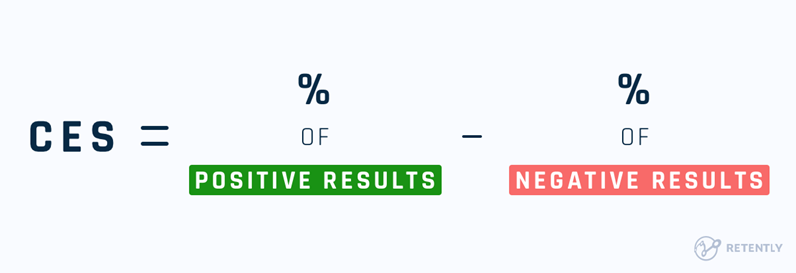
If you are using emoticons or a simple agree/disagree scale, you can calculate the net sentiment of responses by subtracting the number of negative responses from the number of positive ones. This will give you a better understanding of how respondents feel about your question. You can then use this data to tailor future surveys and focus on areas where improvement
What factors affect the Customer Effort Score?
The Customer Effort Score is impacted by several different factors. Some of the factors are
Level of customer service:
The level of customer service provided by the company. Customers may be more satisfied if they receive faster response times, helpful advice, and knowledgeable staff.
Quality of service:
The quality of the product or service being provided. Customers may be more satisfied if the products and services meet their expectations and perform as expected.
Customer’s Experience
The customer experience, from the initial purchase to post-purchase interactions and follow-up. Customers may be more satisfied if their experience is smooth and efficient.
Customer’s Level of Trust:
The customer’s level of trust in the company. Customers may be more satisfied if they feel that the company is trustworthy and reliable.
Customer Satisfaction
The customer’s overall satisfaction with the product or service being provided. This includes how well the product works, how easy it is to use, and how satisfied they are with the overall experience.
Customer’s perception of value for money
The customer’s perception of value for money. Customers may be more satisfied if they feel like they are getting a good deal or getting their money’s worth.
Customer’s level of engagement
The customer’s level of engagement with the company. Customers may be more satisfied if they are actively engaged in the relationship and have a chance to provide feedback or interact with the company on an ongoing basis.
These factors all contribute to a customer’s overall satisfaction and willingness to recommend the company to others. By assessing each factor, companies can identify areas for improvement and develop strategies for increasing customer satisfaction.
With a better understanding of the factors that affect the Customer Effort Score, businesses can focus on providing excellent customer service and experiences that keep customers coming back again and again.
Quotes on Customer Effort Score
“The key to any successful business is making sure your customers are successful first.” – Reid Hoffman, LinkedIn co-founder and investor
“If you do build a great experience, customers tell each other about that. Word of mouth is very powerful.” – Jeff Bezos, Amazon CEO
“The customer effort score is the key metric to measure success. It’s not about how long it took, or how many steps it took, but about the effort required to complete the task.” – Steve Jobs
What is a good Customer Effort Score?
A good Customer Effort Score (CES) can vary depending on the industry, but a general guideline is that a score of 7 or higher indicates that customers had an effortless experience. Scores lower than 7 indicate that there may be areas for improvement in the customer experience, and scores higher than 7 suggest that customers are finding their interactions with the company to be effortless and straightforward.
It’s important to note that the exact definition of a good CES can change depending on the specific industry, so it’s worth doing research into what is seen as an acceptable score in your particular sector.
By understanding what a good CES looks like for your company, you’ll be able to better measure its success in providing an effortless customer experience.
What is an example of a Customer Effort Score?
The customer effort score (CES) is a metric that measures how much effort a customer has to put into interacting with a company. The CES is a predictor of customer loyalty and can be used to identify areas where customers are experiencing high levels of friction.
Here is an example of how to calculate your Customer Effort Score:
- Let’s say you have 10 respondents who score your customer effort on a scale from 1–7 as 3, 4, 7, 6, 6, 8, 6, 5, 7, 7.
Add these scores then divide by the total number of respondents.
(3, 4, 7, 6, 6, 8, 6, 5, 7, 7) ÷ (10)
(59) ÷ (10)
CES= 5.9
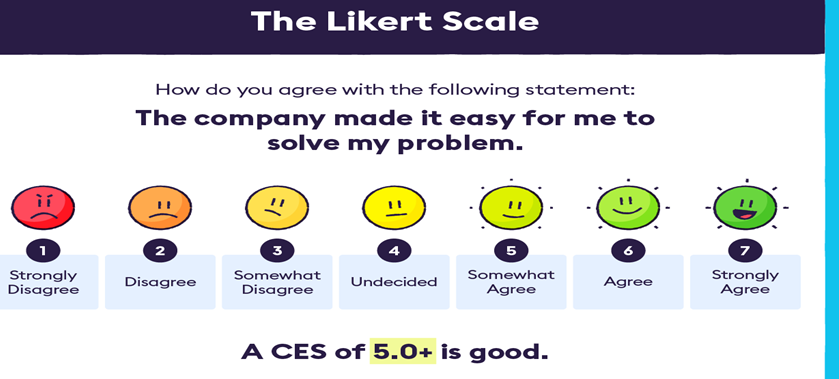
Benchmark Data for Customer Effort Score
Based on Nicereply’s overall distribution, an impressive 44% of customers are highly satisfied with the level of effort it takes to resolve their issue. This is great news!. However, there is still room for improvement – 9% of customers still find it a struggle to get help.
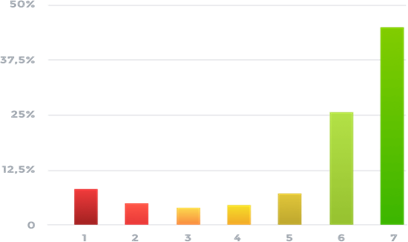
How to improve the Customer Effort Score?
Following are the ways to improve the Customer Effort Score:
Ensure customers have a simple and self-explanatory onboarding process:
A customer’s initial experience with a company will set the tone for their overall satisfaction. Make sure that the process is easy and straightforward, allowing them to find what they need quickly without any confusion.
Offer multiple channels of communication:
Customers should be able to reach out for help and support through a variety of channels such as email, phone, or live chat. Having multiple options will make it easier for customers to contact you quickly and effectively.
Listen to customer feedback:
Make sure that customer feedback is taken seriously and addressed swiftly in order to improve the overall user experience.
Establish clear expectations:
Be upfront and honest with customers about what is expected from them and of your services. This will make it easier for customers to know what to expect, setting realistic expectations and avoiding any confusion or frustration.
Make sure customer service representatives are properly trained:
It’s important that customer service representatives are well-trained and able to handle customer inquiries in a timely manner.
Regularly check for process improvement opportunities:
Analyze processes to ensure that customers are getting the best experience possible. This can include streamlining processes, introducing automation, or making changes based on customer feedback.
Offer incentives:
Offering incentives such as loyalty programs or discounts can help to ensure customers stay on board and remain satisfied with your services.
Make sure customer support is available 24/7:
Offering customer support around the clock will help to provide a better experience for customers, making them feel supported no matter what time it is.
Use customer satisfaction surveys:
Asking customers to fill out surveys can provide valuable feedback on how the customer experience is going.
Create personal relationships with customers:
Building a relationship with customers will make them feel valued and help create trust, leading to better customer loyalty.
These are just some of the ways you can improve your Customer Effort Score (CES). By taking the above steps, you can help ensure that customers have a positive experience with your company and that their needs are being met. This will in turn lead to increased customer loyalty and better overall satisfaction.
Tools to Measure Customer Effort Score
There are numerous tools available to measure Customer Effort Score:
SurveySensum:
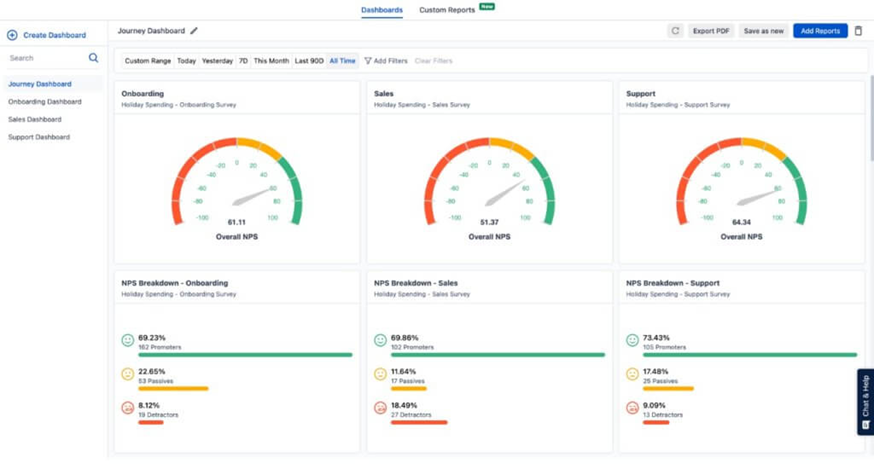
SurveySensum is a cutting-edge CES (Customer Experience Software) tool that is highly efficient in terms of pricing, usability, analytics and results compared to its counterparts in the market.
It utilizes advanced tools such as text analysis, insightful dashboards, word clouds and more to identify dissatisfied customers, personalize surveys, eliminate duplication mistakes, extract meaningful insights from analytics and create faster surveys.
SurveySensum is widely used in the automotive, insurance and BFSI (Banking, Financial Services & Insurance) industries to launch surveys at every customer touchpoint across their journey, gather all feedback into one place, analyze it and close the feedback loop to improve customer experience.
Qualtrics:
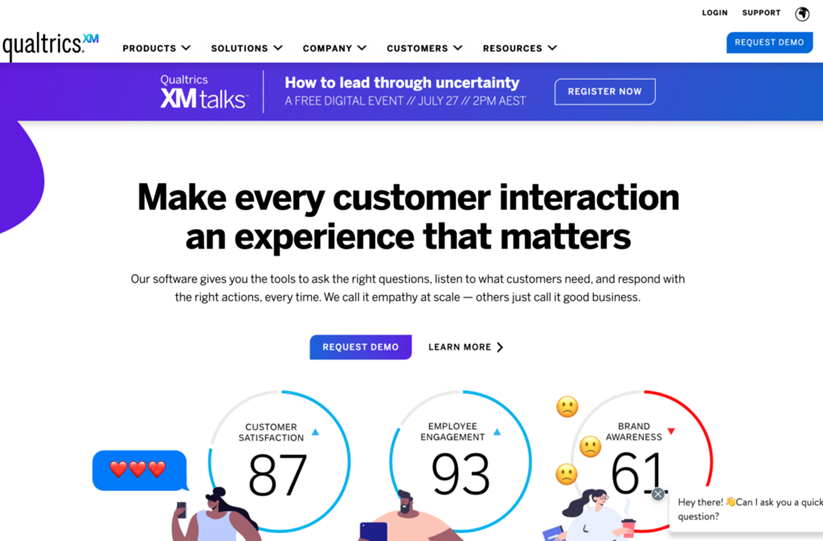
Qualtrics is an effective tool for measuring customer effort scores (CES). It allows companies to gain insight into the customer experience journey, including areas of struggle and success. This tool provides the ability to measure customer effort across different channels, such as phone, website, and in-store. Qualtrics also offers a variety of options for displaying customer feedback and tracking progress over time.
With Qualtrics, companies can measure customer effort using a simple survey that can be completed quickly. The survey is sent out to customers after they have interacted with the company. It includes questions that measure various areas of customer effort such as speed, ease of use, usefulness, and recommendation. Companies can also customize their survey questions to match their specific goals and objectives.
Wrap up
The takeaway is that start-ups should focus on customer effort scores to ensure they are providing an easy customer experience. This will lead to happy customers who stick around, which in turn grows the business. Measuring and improving customer effort scores is not difficult and can be done with surveys sent out after purchase or service interactions.

